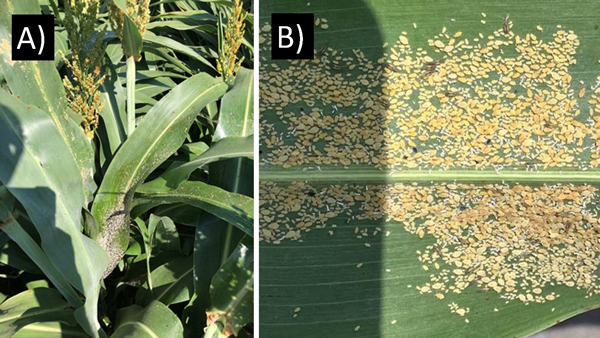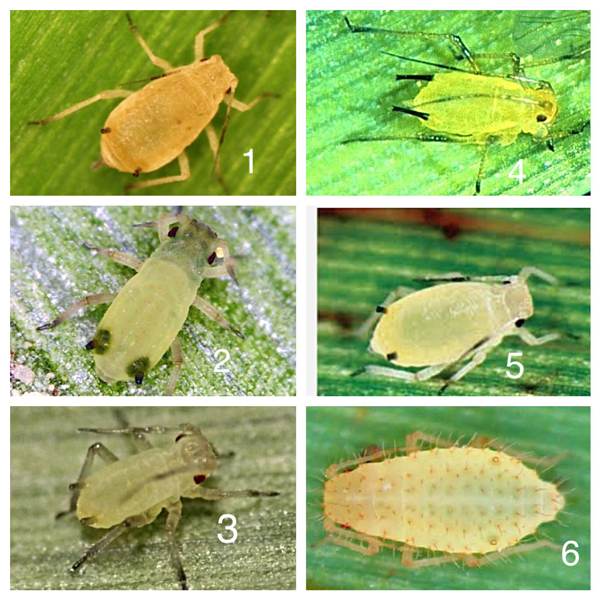Sugarcane (sorghum) aphids were first detected migrating into Kansas in mid-July this year. So far, they have been reported in a south-central to north-central corridor from the Oklahoma border to Ellis County on the west to Geary County on the east, and south of I-70. They are probably north of I-70, but we have not received any verification yet.
According to entomologist Dr. J.P. Michaud, the colonies are small and scattered but a few have gotten large (See Figure 1 provided by M. Pipe from south central Kansas). Fortunately, the beneficials are also plentiful (See Figure 2 which shows green lacewing eggs within 3 feet of aphid colonies). Therefore, please continue to monitor for these aphids because, if past history is any indication, they will continue to migrate into Kansas until late September/early October. The current status of the SCA (now called sorghum aphid) can be found at: https://www.myfields.info/pests/sugarcane-aphid.

Figure 1. A) Sorghum aphids (formerly called sugarcane aphids) in a sorghum field in Ellsworth County, Kansas. Photo by Craig Dinkel, K-State Research and Extension and B) aphid colony found 5 miles north of Hwy 56 (south-central Kansas). Photo by M. Pipes.

Figure 2. A) newly established aphid colonies representative of most fields sampled this past week (i.e., overall populations remain below treatable levels), and B) natural enemies (lady beetles, Harmonia axyridis) feeding on aphid colonies.
Identification of sorghum aphid
There are several similar aphid species on sorghum that could be confused with sorghum aphids especially when the aphids are young. The sorghum aphid has a smooth body with a light-colored head and light-colored legs with dark feet. They have dark-colored, short cornicles (tail pipes) with no shading at the base of them as on the corn leaf aphid, which are blue-green aphids that have purplish patches around their cornicles along with a rectangular body.

1. sugarcane (sorghum) aphid
2. corn leaf aphid nymph
3. corn leaf aphid nymph
4. english grain aphid
5. sugarcane (sorghum) aphid
6. yellow sugarcane aphid
Scouting time for sorghum aphid
Early detection is key to the management of this pest, but treatments should be based on established thresholds. One heavily infested plant does not equal a yield loss. Applying insecticides too soon can result in repeated applications.
Plants are vulnerable to infestation by SCA at any growth stage, but Kansas sorghum is most at risk from the boot stage onward. The ability of sugarcane aphids to overwinter on Johnsongrass and re-sprouting sorghum stubble represents challenges to the management of this pest in more southerly regions.
Issues arising from sorghum aphid in Kansas are likely to become increasingly uncommon with each passing year, especially with natural enemies like lady beetles (Figure 2B) and lacewings providing adequate control during early establishment of aphid colonies (Figure. 2A). It is best practice to scout late-planted fields, as these are more susceptible to yield loss and aphids and this a bigger window for aphids to build to damaging levels later in the season. Also, prioritize fields that were planted to susceptible varieties. Be sure to contact your seed dealer for information on hybrid tolerance to sorghum aphids.
Sampling method
- Once a week, walk 25 feet into the field and examine plants along 50 feet of row:
- If honeydew is present, look for SCA on the underside of a leaf above the honeydew.
- Inspect the underside of leaves from the upper and lower canopy from 15–20 plants per location.
- Sample each side of the field as well as sites near Johnsongrass and tall mutant plants.
- Check at least 4 locations per field for a total 4 locations per field for a total of 60-80 plants.
If no aphids are present, or only a few wingless/winged aphids are on upper leaves, repeat this sampling method once a week thereafter.
If sorghum aphids are found on lower or mid-canopy leaves, begin twice-a-week scouting. Use the same sampling method, but be sure to include % plants with honeydew. Estimate the % of infested plants with large amounts of sorghum aphid honeydew (shiny, sticky substance on leaf surface) to help time foliar insecticides for sorghum aphid control on sorghum (Table 1).
Table 1. SCA Thresholds
|
Growth Stage |
Threshold |
|
Pre-Boot |
20% plants infested with localized areas of heavy honeydew and established aphid colonies |
|
Boot |
20% plants infested with localized areas of heavy honeydew and established aphid colonies |
|
Soft dough |
30% plants infested with localized areas of heavy honeydew and established aphid colonies |
|
Dough |
30% plants infested with localized areas of heavy honeydew and established aphid colonies |
|
Black Layer |
Heavy honeydew and established aphid colonies in head *only treat to prevent harvest problems **observe pre-harvest intervals |
You can download a free sorghum aphid scouting guide here: https://www.myfields.info/sites/default/files/page/ScoutCard%20KSU%20v05312017.pdf
For ongoing current information on the sorghum aphid in Kansas, check out the myFields website often in the coming weeks and months: https://www.myfields.info/pests/sugarcane-aphid
Please email Brian McCornack (mccornac@ksu.edu) with any counties to add to the map!
Brian McCornack, Entomologist
mccornac@ksu.edu
Jeff Whitworth, Entomologist
jwhitwor@ksu.edu
Anthony Zukoff, Extension Associate, Southwest Research-Extension Center
anzukoff@ksu.edu
J.P. Michaud, Entomologist, Agricultural Research Center-Hays
jpmi@ksu.edu